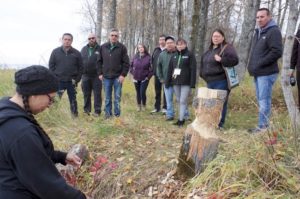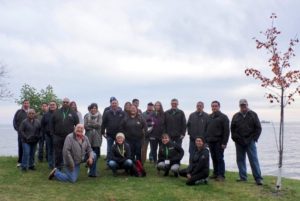Medicine walk enriches cultural knowledge for participants of environment conference

By Rick Garrick
THUNDER BAY — A group of Northern Ontario First Nations Environment Conference participants recently learned about traditional medicines during a medicine walk field trip at the Mission Island Marsh Conservation Area in Thunder Bay.
“I spoke about some of the plants that were in the area and how we used to use them traditionally and the importance of bringing it back into our daily lives,” says Gloria Ranger, cultural resource coordinator with the Thunder Bay Indigenous Friendship Centre and one of the leaders of the Oct. 10 medicine walk. “It was well received. A lot of people had a really good time and enjoyed being outside and getting some hands-on [experience].”
Ranger spoke about some of the traditional uses of the red willow during the medicine walk.
“It was used in a recipe for kinnikinnick, which was a traditional and different form of tobacco,” Ranger says. “But it was also used as an aspirin, and we also used it for other things so it is one of the important plants that are out here.”
Ranger says many of the traditional medicines are located “right in our backyards.
“They are really accessible and medicine isn’t just something that only a few people would know,” Ranger says. “We used to have all of this knowledge in our own families. So it is important for us to learn as much as we can to bring that back into that common knowledge for our people.”
Elder Tony DePerry, another medicine walk leader, says there was a good response from the participants.
“To me, they were satisfied, they were eager to listen, to pay attention,” DePerry says. “It is very important that these people have the curiosity to learn and to find out what is what.”
The Oct. 9-10 conference also included field trips to two different greenhouses and the City of Thunder Bay Waste and Recycling Facility as well as a variety of presentations and workshops, including a presentation, Practical Ways of Adapting to Climate Change in Northern Communities by David Pearson, a professor of environmental studies at Laurentian University in Sudbury.

“The aim of the exercise was to encourage people to look at climate related problems, weather related problems that they need to prepare for in their community, for example, an increasing frequency of rain in the winter on frozen ground that runs off and into crawl spaces and basements and can cause mould,” Pearson says. “I was encouraging people to look at their drainage systems to make sure culverts were open so that roads wouldn’t flood if rain fell and the ground was still frozen and ways of protecting culverts from debris getting into them and freezing like a dam during the winter and stopping the water.”
Pearson also raised the issue of heat stress for Elders and infants and the importance of informing them about a cool space in the community.
“They need to know that they’d be welcome there if the temperature gets high,” Pearson says.
Laura Sayers, environmental advisor with Shibogama First Nations Council, says the conference focused on three streams: wastes and landfills, environmental sustainability, and engaging opportunities.
“There’s always new information to be shared about the environment and there’s always new people that we can bring in to share their stories and their experiences,” Sayers says. “A big part of the event is that networking and that sharing amongst the communities, but also from our environmental professionals that we brought in to do some of these presentations.”
About 150 delegates from 12 tribal councils registered for the conference, including from Mamaweswen, The North Shore Tribal Council, and Nokiiwin Tribal Council.


